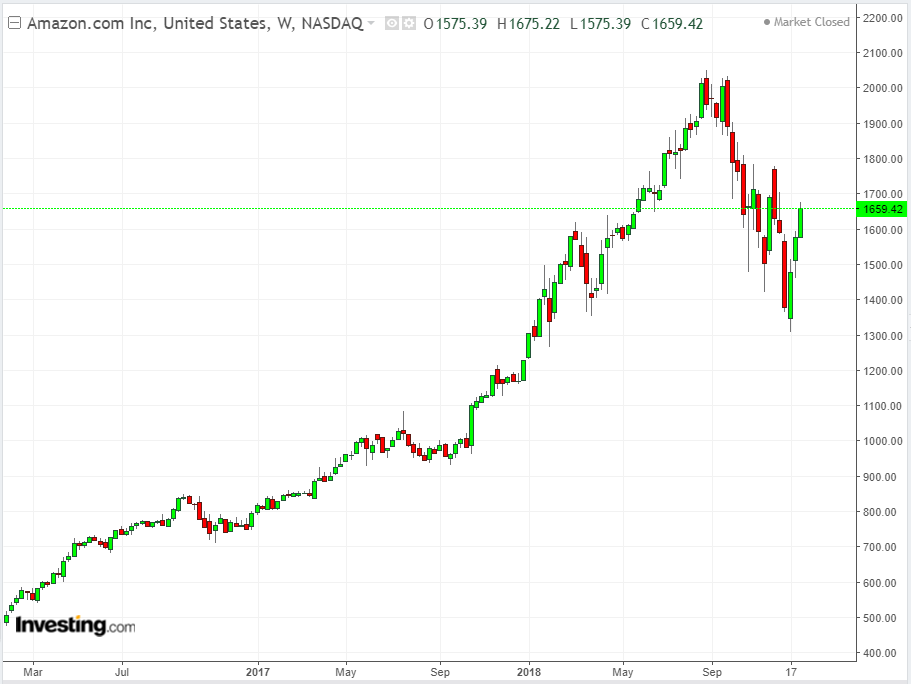Amazon (NASDAQ:AMZN) was just one of only two FAANG stocks to finish 2018 in the green. The world's largest e-commerce retailer delivered a 28.4% return on the year, bested only by Netfilx.

Despite the sharp pullback in the e-commerce and cloud-computing titan's stock since early October, the annual result is still stunning, considering the broader market was down last year. The S&P 500 and NASDAQ indexes declined 4.4% and 3.9% respectively.
Going forward, given how difficult the final quarter of last year was for high-growth tech stocks, it makes sense for investors to question whether they should continue to favor the world’s most valuable company by market cap over other tech giants?
Amazon’s third quarter earnings report took many investors by surprise as growth in its core business, selling merchandise online, has been slowing quarter-over-quarter for four consecutive periods. That deceleration made many wonder whether the company is reaching a saturation point.
We believe two factors will determine whether Amazon’s growth engine is intact and still strong enough to thrive in this adverse market for growth stocks.
1. E-commerce Expansion in North America
The company can’t afford any slowing of its online sales. Amazon is the largest online retailer in North America. That competitive advantage is crucial for the company to continue to grow at a pace that satisfies investors. We don't see any threat to that dominance in the foreseeable future.
According to researchers at eMarketer, Amazon is likely to finish 2018 having cleared $258.22 billion in US retail sales. That would represent 49.1% of all online retail spending in the country.
The company, which started as an online bookstore, is now leading in all areas of e-commerce, fueled by a strong Marketplace network of third-party sellers, an ever-expanding range of goods on offer, from groceries to fashion, and a very popular loyalty program in the form of Prime.
This persistent dominance also gives Amazon immense power to disrupt many established industries, creating new opportunities. Its acquisition of organic grocery chain Whole Foods in mid-2017 was a move that shook—and continues to shake—the entire brick-and-mortar retail sector.
Amazon has extended itself into an ever widening array of industries, from advertising to voice-activated gadgets to streaming media. In recent quarters it has also started focusing more intensely on making money, in addition to growth.
Still, there are risks that may disrupt the company’s upward progression. If the US economy goes into a recession, or the US-China trade war forces both big and small businesses to cut their spending, Amazon will certainly feel the heat.
Should the company continue to expand across additional industries it could also attract regulatory scrutiny. President Donald Trump has repeatedly attacked Amazon, especially on social media and in interviews, alleging the company's dominant position is hurting American retailers and the postal service.
Nevertheless, despite these risks, Amazon is still making a lot of money. In its most recent quarter, operating income surged from $347 million in the year-ago quarter to $3.7 billion. And in the nine-month period to September 30, operating income was $8.6 billion—up from $1.9 billion during the same period a year ago. For the final quarter of 2018, Amazon is projected to report a 20% gain in sales from a year earlier, according to FactSet.
2. Amazon Web Services
The other major contributor to Amazon’s earnings momentum is its web services business (AWS). This is one of its fastest-growing business segments, with several big players—including Microsoft (NASDAQ:MSFT), Google (NASDAQ:GOOGL) and IBM (NYSE:IBM)—vying for market share. Currently, Amazon is again the dominant player with over 30% of the market.
Though the contribution of Amazon's web services division to the company's overall sales doesn't seem to be especially big, the cloud-computing business is increasingly becoming important for Amazon’s bottom line. For the trailing-nine-month period ending September 30, for instance, AWS's operating income of $5.1 billion contributed 73% of Amazon's consolidated operating income.
However, that segment of the digital economy is becoming increasingly competitive. Indeed, all the other major tech players are also trying to make inroads into the business.
Microsoft, for example, has been working to transform themselves into a seller of cloud services for businesses who want to store data and run applications from Microsoft’s own data centers, rather than investing significant capital in in-house technology and maintenance.
In the latest quarter, Microsoft commercial cloud sales rose 47% to $8.5 billion, while margins for that business widened by 4 percentage points to 62%.
Bottom Line
Amazon’s leading position in many of the areas in which it operates makes its stock one of the safest bets in the tech sector. Of course, at $1,659.42 as of yesterday's close, it's not cheap. Bear in mind, however, that it's still down almost 20% from its high of $2,050.50 in early September. As such, investors should be careful in taking a position when the risks to growth stocks have elevated.
In addition, when Amazon reports Q4 2018 results on Thursday, January 31, after the close, if there are signs that its AWS business is under pressure due to competition, or its bread-and-butter e-commerce business is nearing a peak, the stock will react very negatively. But if you’re looking for a buy-and-hold investment, Amazon is the type of stock that becomes attractive after losing nearly a quarter of its value over such a short period of time.
